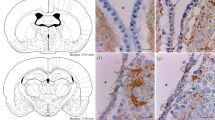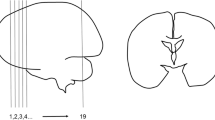Summary
-
1.
The reaction of the ependymal cells in the pars nervosa of the pituitary has been investigated after section of the pituitary stalk.
-
2.
In the pars nervosa of the lamprey Lampetra planeri Bloch there are only ependymal cells and intermediate neurosecretory axons of the tractus praeoptico-hypophysis. The ependymal cells consist of a perikaryon and a slender process. Towards the recessus infundibuli the perikarya form an epithelium-like boundary; the processes are arranged in a palisade-like pattern. The ependymal cells do not contain any demonstrable neurosecretory material.
-
3.
2–3 weeks after the section of the pituitary stalk the axons of the pars nervosa of the pituitary start to resolve. The degeneration begins with the decomposition of the axolemma, of the mitochondria and of the vesicular structures. The neurosecretory granules do not change and after degeneration of the axons they lie free between the ependymal cells.
-
4.
3–4 weeks post operation the ependymal cells start phagocytating the neurosecretory granules. Thereby no single, but groups of granules reach the ependymal cells. Here the granules break down and the products of degradation are released into the cerebrospinal fluid. In this phase the ependymal cells show characteristic reactions. It is possible to stain the neurosecretory material with the chrome hematoxylin or pseudoisocyanin technique up to their complete degradation.
-
5.
The immigration of regenerating axons into the pars nervosa begins after 4–5 weeks. After 6–8 weeks the original condition of the pars nervosa is restored.
-
6.
Phagocytosis is supposed to be a basic function of the ependymal cells. Commonly the neurosecretory materials are degradated within the axons, the products of degradation are released into the intercellular clefts and reach by way of ependymal cells the cerebrospinal fluid. It is possible that at this basis a “feedback” has phylogenetically developed, as postulated by Knowles and Vollrath (1966) in the eel. These authors supposed that a secretion of the pituicytes stimulates by way of cerebrospinal fluid the production of neurosecretory materials in the hypothalamus.
Zusammenfassung
-
1.
Untersucht wurde die Funktion der Ependymzellen in der Neurohypophyse nach Hypophysenstieldurchtrennung.
-
2.
Die Neurohypophyse von Lampetra planeri Bloch setzt sich aus Ependymzellen und dazwischenliegenden neurosekretorischen Axonen des Tractus praeoptico-hypophyseus zusammen. Die Ependymzellen bestehen aus einem Perikaryon und einem schlanken Fortsatz. Die Perikaryen bilden gegen den Recessus infundibuli hin einen epithelartigen Abschluß, die Fortsätze sind palisadenartig angeordnet. Die Ependymzellen enthalten im Normalfall kein nachweisbares Neurosekret.
-
3.
2–3 Wochen nach Hypophysenstieldurchtrennung degenerieren die Axone in der Neurohypophyse. Die Degeneration beginnt mit der Auflösung des Axolemmas, der Mitochondrien und der vesiculären Strukturen. Die neurosekretorischen Elementargranula verändern sich nicht und liegen nach der Degeneration der Axone frei zwischen den Ependymzellen.
-
4.
3–4 Wochen post Operationem beginnen die Ependymzellen die Neurosekretgranula zu phagozytieren. Dabei gelangen nicht einzelne, sondern ganze Ballen von Elementargranula in die Ependymzellen. In diesen werden die Granula abgebaut; die Abbauprodukte werden in den Liquor cerebrospinalis abgegeben. Die Ependymzellen zeigen in dieser Phase charakteristische Reaktionsformen. Die Neurosekrete lassen sich bis zu ihrem völligen Abbau mit Chromhaematoxylin oder Pseudoisocyanin darstellen.
-
5.
Die Einwanderung von regenerierenden Axonen in die Neurohypophyse beginnt nach 4–5 Wochen. Nach 6–8 Wochen ist der ursprüngliche Zustand in der Neurohypophyse wieder erreicht.
-
6.
Es wird angenommen, daß die Phagozytose eine Grundfunktion der Ependymzellen ist. Im Normalfall wird das Neurosekret in den Axonen abgebaut, die Abbauprodukte gelangen über die Interzellularspalten in die Ependymzellen und werden von hier in den Liquor cerebrospinalis abgegeben. Auf dieser Basis könnte stammesgeschichtlich ein „feedback“ entstanden sein, wie er von Knowles und Vollrath (1966) postuliert wurde. Diese Autoren nehmen an, daß ein Sekret der Pituizyten die Produktion der Neurosekrete im Hypothalamus über den Liquor stimuliert.
Similar content being viewed by others
Literatur
Adam, H.: Der III. Ventrikel und die mikroskopische Struktur seiner Wände bei Lampetra fluviatilis L. (Petromyzon) und Myxine glutinosa L. nebst einigen Bemerkungen über das Infundibularorgan von Branchiostoma (Amphioxus) lanceolatum Pall. In: Progress in neurobiology. First Meeting of Neurobiol. Groningen 1955, p. 146–158. Amsterdam: Elsevier Publ. Co. 1956.
Bargmann, W.: Über das Zwischenhirn-Hypophysensystem von Fischen. Z. Zellforsch. 38, 275–298 (1953).
—, u. A. Knoop: Elektronenmikroskopische Beobachtungen an der Neurohypophyse. Z. Zellforsch. 46, 242–251 (1957).
— —: Über die morphologischen Beziehungen des neurosekretorischen Zwischenhirnsystems zum Zwischenlappen der Hypophyse (Licht- und elektronenmikroskopische Untersuchungen). Z. Zellforsch. 52, 256–277 (1960).
Douglas, W. W., and A. M. Poisner: Stimulus-secretion coupling in a neurosecretory organ: The role of calcium in the release of vasopressin from the neurohypophysis. J. Physiol. (Lond.) 172, 1–18 (1964).
Fujita, H., and J. F. Hartmann: Electron microscopy of neurohypophysis in normal, adrenaline-treated and pilocarpin-treated rabbits. Z. Zellforsch. 54, 734–763 (1961).
Gersh, I.: The structure and function of the parenchymatous glandular cells in the neurohypophysis of the rat. Amer. J. Anat. 64, 407–429 (1939).
—, and C. Mc. C. Brooks: Correlation of physiological and cytological changes in the neurohypophysis of rats with experimental diabetes insipidus. Endocrinology 28, 6–19 (1941).
Gorbman, A.: Vascular relations between the neurohypophysis and adenohypophysis of cyclostomes and the problem of evolution of hypothalamic neuroendocrine control. Arch. Anat. micr. Morph. exp. 45, 163–194 (1965).
Green, J. D., and V. van Breemen: Electron microscopy of the pituitary and observations on neurosecretion. Amer. J. Anat. 97, 177–227 (1955).
Haller, E. W., H. Sachs, N. Sperelakis, and L. Share: Release of vasopressin from isolated guinea pig posterior pituitaries. Amer. J. Physiol. 209, 79–83 (1965).
Heier, P.: Fundamental principles in the structure of the brain of Petromyzon fluviatilis. Acta anat. (Basel), Suppl. 8, 1–213 (1948).
Hild, W.: Experimentell-morphologische Untersuchungen über das Verhalten der „Neurosekretorischen Bahn“ nach Hypophysenstieldurchtrennungen, Eingriffen in den Wasserhaushalt und Belastung der Osmoregulation. Virchows Arch. path. Anat. 319, 526–546 (1951).
Hodkin, A. L., and R. D. Keynes: Movements of labeled calcium in squid giant axon. J. Physiol. (Lond.) 138, 253–281 (1957).
Knowles, F., and L. Vollrath: Neurosecretory innervation of the pituitary of the eels Anguilla and Conger, I: The structure and ultrastructure of the neuro-intermediate lobe under normal and experimental conditions. Phil. Trans. B 250, 311–328 (1966).
Mikiten, T. M., and W. W. Douglas: Effect of calcium and other ions on vasopressin release from rat neurohypophysis stimulated electrically in vitro. Nature (Lond.) 207, 302 (1965).
Müller, H.: Elektronenmikroskopische Untersuchungen der „Neurohypophyse“ vom Bachneunauge Lampetra planeri (Bloch). In: Electron microscopy, 1964. 3. European Regional Conf. on Electron Microscopy, Prague 1964. Prague: Publ. House of the Czechoslovak Academy of Sci. 1964a, p. 479–480.
—: Zur Feinstruktur der „Neurohypophyse“ vom Bachneunauge Lampetra planeri (Bloch). Biol. Rdsch. 1, 228–230 (1964b).
Pearse, A. G. E.: Histochemistry, theoretical and applied, 2. ed., p. 882. London: J. &. A. Churchill Ltd. 1960.
Romeis, B.: Die Hypophyse. In: Handbuch der mikroskopischen Anatomie des Menschen, Bd. VI/3. Berlin: Springer 1940.
Sterba, G.: Fluoreszenzmikroskopische Untersuchungen über die Neurosekretion beim Bachneunauge (Lampetra planeri Bloch). Z. Zellforsch. 55, 763–789 (1961).
—: Grundlagen des histochemischen und biochemischen Nachweises von Neurosekret (Trägerprotein der Oxytocine) mit Pseudoisozyaninen. Acta histochem. (Jena) 17, 268–292 (1964a).
—: La preuve histochimique de l'identité de la substance décelable comme neurosécrétat et de la protéine liée à l'oxytocine. Ann. Endocr. (Paris) 25, 128–132 (1964b).
—, u. K.-P. Wellner: Biochemische Korrelation der Pseudoisocyaninreaktion zum Nachweis von Neurosekret. Naturwissenschaften 50, 334–335 (1963).
Wohlfarth-Bottermann, K. E.: Die Kontrastierung tierischer Zellen und Gewebe im Rahmen ihrer elektronenmikroskopischen Untersuchungen an ultradünnen Schnitten. Naturwissenschaften 44, 287–288 (1957).
Author information
Authors and Affiliations
Rights and permissions
About this article
Cite this article
Sterba, G., Brückner, G. Zur Funktion der ependymalen Glia in der Neurohypophyse. Z.Zellforsch 81, 457–473 (1967). https://doi.org/10.1007/BF00541008
Received:
Issue Date:
DOI: https://doi.org/10.1007/BF00541008




